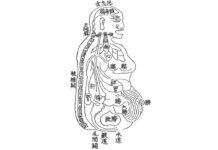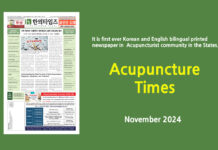Written By Jun Heo(許浚, 1539~1615), Translated by Namil Kim, Wung Seok Cha et al., Published by Ministry of Health & Welfare (Korea)
01 The Shape of the Lungs 肺形象 폐의 형상
① The shape of the lungs resembles the shape of a person’s shoulders. It has two spread leaves, many small leaves and 24 holes in the center which disperse the clear and turbid qi of the various organs. It governs the storage of the corporeal soul.
② The weight of the lungs is 3 geun 3 nyang. There are 2 ears attached to 6 leaves, which total up to 8 leaves.
③ The shape of the lungs resembles the shape of a person’s shoulders. It hangs above the five viscera like a bell. This resembles an umbrella.
02 Area of the Lungs 肺部位 폐의 부위
① The lungs store from the right side.
② There are two kinds of lung system. One is connected to the larynx. This is also connected to the heart system from the center. The other one starts from the heart and goes between the two leaves of the lungs and then bends towards the back.
③ LU1 is the alarm point of the lungs. It is located above the nipple in the space between the 3rd and 4th ribs. BL13 is located under the third vertebra. These are the areas of the lungs.
03 Time and Day When the Lungs Govern 肺主時日 폐가 주관하는 시간과 날짜
① The lungs govern fall, control hand greater yin and hand bright yang, and govern the Gyeong and Sin days (庚辛日).
② The western direction engenders dryness, dryness engenders Metal, Metal engenders hot taste, and hot taste engenders the lungs.
③ The lungs are greater yin of yang, and correspond to the qi of fall.
04 Things Belonging to the Lungs 肺屬物類 폐에 속하는 것들
The lungs are dryness in heaven, Metal on earth. They are the Tae trigram in the Book of Changes and hair in the five bodies. They are the lungs in the five viscera and the color white in the five colors. They are the Sang sound (商) in the five notes and the crying sound in the five sounds. They are the cough in the five changes and the nose in the five orifices. They are hot taste in the five tastes and anxiety in the five emotions. The corresponding vessel is hand greater yin and the corresponding secretion is nasal discharge.
The state of the lungs is manifested in the hair. The corresponding smell is fishy and the corresponding number is nine. The corresponding grain is rice and the corresponding domestic animal is the chicken (some texts mention horse). The corresponding animal group is animals with shells. The corresponding fruit is peach and the corresponding vegetable is the spring onion. The corresponding meridian is hand greater yin.
05 The Size of the Lungs 肺臟大小 폐장의 대소
① The lungs are the cover for the five viscera and six bowels.
② White skin with dense interstices indicate small lungs, and with rough interstices indicate big lungs. Broad shoulders, protruding chest, and a dented throat are indications of high-positioned lungs, while narrow shoulders and a broad waist indicate low-positioned lungs. Big shoulders with a thick back indicate that the lungs are healthy, while thin shoulders and back indicate weak lungs. The thick back and chest mean neat lungs, and the unilateral looseness of the rib-side means the
lungs are tilted to one side.
③ The person with small lungs can drink only small amounts of water and does not suffer from dyspnea or heatstroke. On
the other hand, the person with big lungs drinks a lot of water, and the person suffers from the chest impediment, throat impediment, and the upflow of qi. In high-positioned lungs, qi flows upward, and makes the person breath with moving the shoulders and coughing. In low-positioned lungs, qi may push the lungs and cause pain under the rib-side. When the lungs are stable, the person does not cough, and qi does not flow upward. When the lungs are weak, the person tends to suffer from wasting-thirst. When the lungs are neat, the lungs do not get hurt easily because the lungs are harmonious, and when
the lungs are tilted, one side of the chest will be painful.
06 Symptoms of Lung Damage 肺傷證 폐상증
① Drinking cold beverages when the body is cold will damage the lungs.
② When a person with damaged lungs gets tired, he or she will cough with hemoptysis. Hemoptysis occurs in the person with a fine, tight, floating, and rapid pulse. This is because the lungs are damaged and qi is blocked due to impetuous behavior and frequent anger.
③ When heat is in the upper energizer, the person will cough and it becomes lung atrophy. When a person coughs turbid foam and has a rapid wrist pulse, it is lung atrophy. If the person coughs while the mouth is dry and feels continuous pain in the chest while coughing, with a slippery and rapid pulse, it is a lung abscess.
07 Symptoms of Lung Disease 肺病證 폐병증
① When the pathogen is in the lungs, the following symptoms are observed: pain all over the skin, chills and fever, sweating and dyspnea due to the upflow of qi, and movement of the shoulders and back when coughing.
② When wind and cold pathogens invade the lungs to stay, it is called a lung impediment. The symptoms are coughing with dyspnea.
③ When a person has a lung disease, the following symptoms are observed: shortness of breath, coughing, upflow of qi, pain in the shoulders and back, sweating, and pain along the sacrum, thighs, knees, calves, shins, and feet. If the lungs are deficient, the person becomes powerless, has difficultly in continuing breathing, and develops deafness and dry throat.
④ When the person has lung heat, the person’s facial complexion becomes white and the hair dries.
⑤ The external symptoms are white face, frequent sneezing, frequent sadness and the lack of joy, and the urge to cry. The internal symptoms are stirring qi in the right side of the umbilicus which is hard and painful upon pressure. When the lungs are diseased, the person experiences coughing with dyspnea, chills and a fever.
⑥ The person will die in six months if the bones and muscles of the thigh region lose weight with chest fullness, dyspnea, and the moving of the shoulders while breathing. If a true visceral pulse is observed, the person will die soon. This refers to the lungs. The person will die in 180 days.
08 Deficiency and Excess of Lung Disease 肺病虛實 폐병의 허실
① When lung qi is deficient, the person will have a lack of energy and difficulty in breathing. When lung qi is excessive, the person will have dyspnea and will bend the head back to breathe.
② The lungs stores qi. When qi is remaining, the person will cough with the upflow of qi. When qi is deficient, the person will breathe normally but will be out of spirit.
③ When the lungs are excessive, the person will experience the upflow of qi and back pain. When the lungs are deficient, the person will experience dyspnea and cough while breathing powerlessly. Also, the upflow of qi will cause hemoptysis and unusual sounds coming from the chest.
09 Time and Day When Lung Disease Is Cured or Aggravated 肺病間甚 폐병이 낫거나 심해지는 때
① When the lungs are diseased, it will be cured in winter. If it is not cured in winter, it becomes worse in summer. If the person does not die in summer, it stays in the long summer and gets better in fall.
② lung disease is cured on the days of Yim and Gye (壬癸日). When it is not cured on the days of Yim and Gye (壬癸日), it gets worse on the days of Byeong and Jeong (丙丁日). When it is not cured on the days of Byeong and Jeong (丙丁日), it stays on the day of Mu and Gi (戊己日) and ameliorates on the days of Gyeong and Sin (庚辛日). ③ lung disease gets better at sunset, gets worse in the middle of the day, and becomes stable at night.
10 Treatment Methods for Lung Disease 肺病治法 폐병 치료법
① The lungs dislike the upflow of qi, so qi should be brought down with a bitter taste. The Annotation says, “lung qi flows upward because qi is remaining.” The lungs tend to contract, so it should be contracted with a sour taste. Tonify with a sour taste and purge with a hot taste.
② When the lungs suffer from the upflow of qi, Terminaliae Fructus (訶子皮) (some say Scutellariae Radix (黃芩)) should be used and when the lungs try to contract, Paeoniae Radix (白芍藥) should be used. The lungs should be tonified by a sour taste like Schisandrae Fructus (五味子). The lungs should be purged by a hot taste like Mori Cortex (桑白皮).
③ Take millet, chicken, peaches, and green onions for a lung disease. It is taking the original taste.[B002] ④ Take barley, lamb, apricots, and scallions for lung disease. This brings qi down by the bitter taste.
⑤ Avoid cold food and cold clothes in lung disease.
⑥ Prescribe Tonify Lungs Powder or Unaccompanied Ginseng Decoction (獨參湯) for lung deficiencies, and Drain White Powder or Ginseng Drain Lungs Decoction for lung excesses.
- Tonify Lungs Powder 補肺散 보폐산: ① It is also called Ass Hide Gelatin Powder. It treats lung deficiencies. 2 don of Asini Corii Colla (阿膠珠), 1.2 don of Arctii Semen (牛蒡子) and waxy rice (roasted), 7 pun of Aristolochiae Fructus (馬兜鈴) (stir-fried), 5 pun of Glycyrrhizae Radix (甘草) (stir-fried) and 9 Armeniacae Semen (杏仁) (stir-fried with wheat bran). Cut these herbs to make 1 package. Boil with water. (Some say waxy rice is in fact millet).
- Drain White Powder 瀉白散 사백산: This is also known as Drain the Lungs Powder. It treats lung excesses. 2 don of Mori Cortex (桑白皮) and Lycii Radicis Cortex (地骨皮), 1 don of Glycyrrhizae Radix (甘草). Cut these herbs to make 1 package. Boil with water. Adding Anemarrhenae Rhizoma (知母), Bulbus Fritillariae Cirrhosae (貝母), Platycodonis Radix (桔梗), Liriopis Tuber (麥門冬), and Rehmanniae Radix Crudus (生地黃) would be fine.
- Ginseng Drain Lungs Decoction 人參瀉肺湯 인삼사폐탕: It treats excessive heat in the lungs. 7 pun of Scutellariae Radix (黃芩), Gardeniae Fructus (梔子), Aruantii Fructus Immaturus (枳殼), Menthae Herba (薄荷), Forsythiae Fructus (連翹), Armeniacae Semen (杏仁), Mori Cortex (桑白皮), Rhei Radix et Rhizoma (大黃) (steamed with alcohol), Platycodonis Radix (桔梗), and Glycyrrhizae Radix (甘草). Cut these drugs and make 1 package. Boil this with water.



































